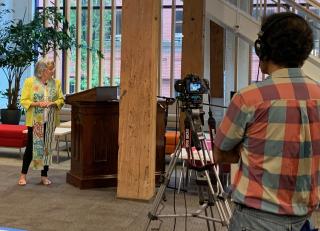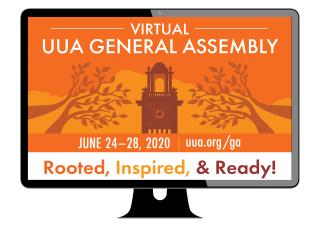Advertisement
General Assembly, the Unitarian Universalist Association’s annual meeting, is meticulously planned months and even years ahead in order to provide the best experience for the thousands of UUs who arrive each June for an exciting, in-person experience.
So in the spring of 2020, as the COVID-19 pandemic gained momentum and public health officials began to urge people to stay home and to especially avoid large gatherings, the UUA administration and the GA Planning Committee faced a momentous decision: whether to proceed as planned to Providence, Rhode Island, June 24–28 for the usual in-person GA—for which thousands of UUs had already registered—or to swiftly pivot to an all-virtual GA that people would attend online, something the UUA had never done before.
LaTonya Richardson was in her first year as UUA General Assembly and Conference Services director, having taken over the role from longtime director Jan Sneegas last year. An experienced conference director, Richardson didn’t let the unprecedented challenge throw her. As the pandemic accelerated in March, she decided on a “two-train approach,” as she calls it, continuing with plans for GA in Providence while also beginning to brainstorm all that a virtual GA would entail.
Watch events from the UUA’s Virtual General Assembly.
General Assembly 2020 Online Events for Public Viewing
For weeks, both options remained in play as Richardson and UUA leaders closely watched the recommendations of the Centers for Disease Control and Prevention, the conferences industry, and others. As UUA leaders contemplated a virtual GA, a major consideration was honoring its contractual, legal, and fiduciary obligations already in place for GA 2020, Richardson says. The leadership also considered that 70 percent of GA attendees typically are over 55 years old, an age group more susceptible to COVID-19. “The accessibility, safety, and well-being of people was also critical throughout this whole analysis,” says Richardson.
In early April, given travel restrictions, stay-at-home orders, and restrictions on the size of gatherings of people in Rhode Island and much of the country, UUA leaders were clear that a virtual GA was the best decision. The UUA Board of Trustees voted on April 13 to approve the plan, and the UUA announced it publicly on April 16.
With about eight weeks to go, the UUA staff and the GA Planning Committee shifted into high gear to create a virtual GA. But rather than a reaction to a crisis, Richardson saw it as an “exciting opportunity” to reimagine GA, including increasing its accessibility to more UUs. Since the cost of online registration was $150 versus $400 for in-person, and there would be no travel or hotel costs, UUA leaders hoped Virtual GA 2020 might be one of the best-attended GAs ever—and recognized that it offered other benefits important to UU values, including a much reduced carbon footprint.
It was important that Virtual GA offer the kinds of experiences that UUs expect, but at the same time, it was clear people wouldn’t want to sit in front of a computer twelve hours a day for five days, Richardson says. “We tried to prioritize: What is most important, what is the heart of GA?” she says. Input was sought from a variety of groups, including Diverse & Revolutionary UU Multicultural Ministries, the Liberal Religious Educators Association, the UU Ministers Association, and Black Lives of UU.
“My colleagues on the GA Planning Committee spent many hours in conversation deeply engaged with the nuts and bolts of what it would mean to put this together in a way that continued to honor the forward movement of our faith communities,” says Cecilia Hayes, a member of the all-volunteer committee. “What to me was so surprising was the rapidity—once the decision was made—that it actually happened.”
The business aspects of GA are required by Association bylaws, but other parts have become important to UUs, including celebratory and worship services. Opportunities for people to make connections, including with UUA leadership, were essential. The work of the Commission on Institutional Change, which after three years had just released its final report on systemic racism in the faith and recommendations for countering white supremacy, would be centered. It was also essential to acknowledge the 400th anniversary of the Pilgrims’ arrival in what is now Massachusetts, with programs highlighting the ongoing violence of colonization and the powerful legacy of 400 years of Indigenous resistance.
“[Richardson] was instrumental in making the transition smooth and seamless as it was executed,” says Hayes. “She made sure all the parts were moving in a way that was harmonious and that folks felt like they were heard, seen, and respected, and that the best ideas surfaced to the top.”
Then the big question: How to move these essential pieces online? That’s where Larry Stritof, the UUA’s systems and apps development manager, did what Richardson and others call near-heroic work. For years GA had livestreamed certain sessions and included about 300 off-site participants each year. But scaling up to include the 4,000-plus expected for Virtual GA was a huge technical undertaking, especially for the two-person team of Stritof and the UUA’s primary developer, Paul Mullin. To assist them, the UUA hired outside developers to help scale up its system so that it wouldn’t crash when thousands of people logged in at the same time.
Programming had to be reimagined for online, including training presenters to move to the new format and encouraging them to prerecord their presentations to avoid technical problems that might occur live. There would be four workshop blocks during GA, each with ten workshops, so the IT staff was running forty online workshops—ten at a time—plus another five workshops related to the work of the Commission on Institutional Change, as well as the major events of Sunday Worship, the Ware Lecture, and more. Prior GAs never streamed more than two events at a time, Stritof notes. To manage so many simultaneous online events, UUA Web Team Manager Margy Levine Young convened about ninety volunteers who had different tasks, including running Zoom meetings for presenters, monitoring the chats in Zoom and other meetings, and answering questions from attendees. And every workshop had live transcription, which is not the case for regular GAs.
One misconception the team encountered was that Virtual GA had no costs. Richardson points out there are significant costs, including greatly increased technology and production costs. Meanwhile, income for GA 2020 dropped dramatically. In-person registrations were converted to virtual registrations, with registrants offered options for handling the $250 difference, including a refund. Exhibitors and sponsors also were offered refunds. A number participated in a virtual exhibit hall; others chose to apply their registration to 2021.
In the end, the “big experiment,” as Richardson referred to it, paid off: 4,933 people attended Virtual GA, making it the third largest General Assembly on record. “It was a tremendous feat of learning,” says Stritof, “but the responses we’ve heard and that we’ve seen online have been overwhelmingly positive.”

